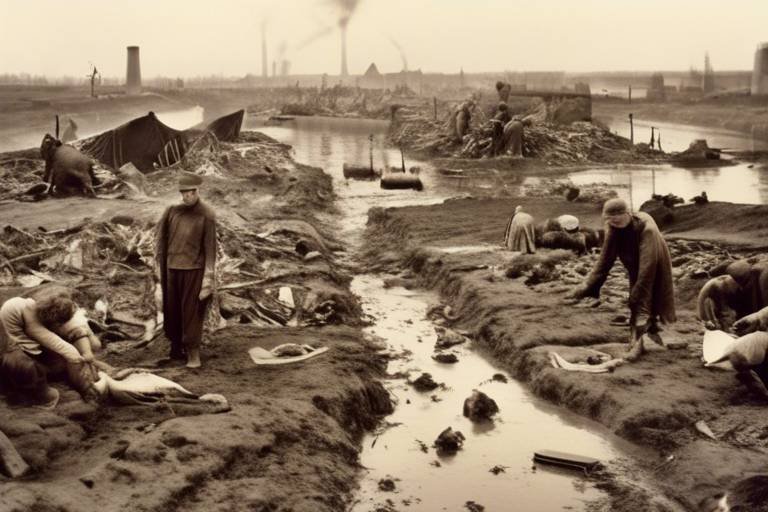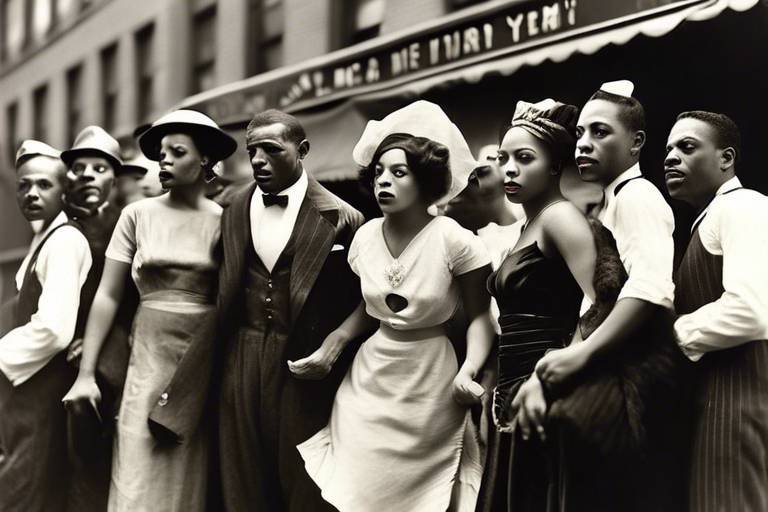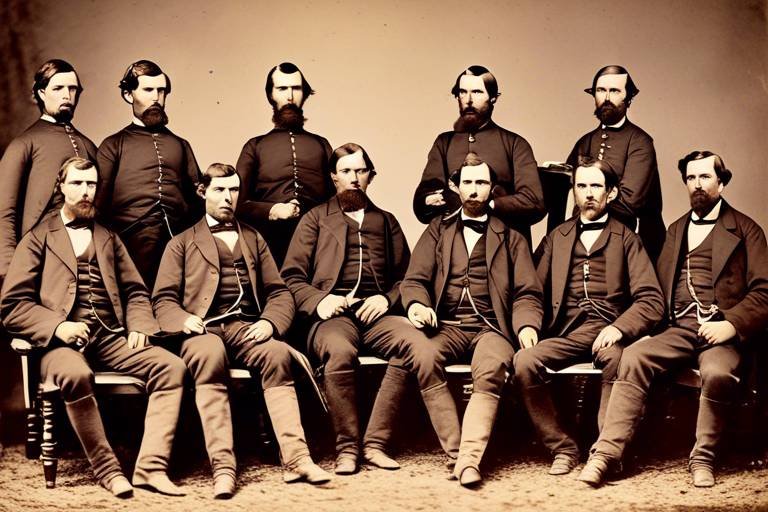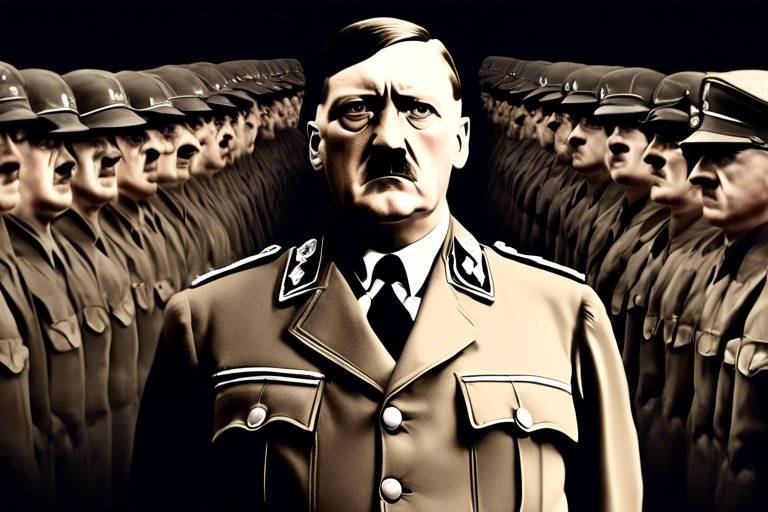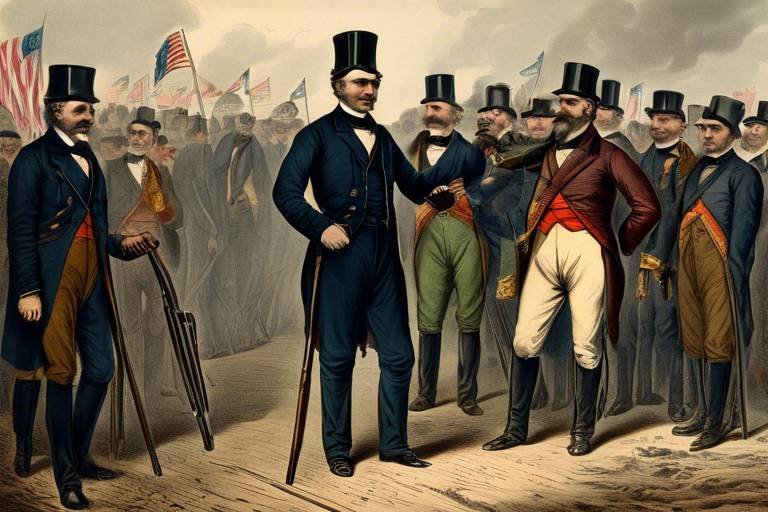The Industrial Revolution - Innovations That Changed Lives
The Industrial Revolution marked a pivotal moment in history, characterized by a wave of innovations that reshaped society and revolutionized various aspects of daily life. One of the most transformative inventions of this era was the steam engine, which not only revolutionized transportation but also powered manufacturing processes, leading to faster travel and increased production efficiency. Imagine the world before steam power, where everything moved at a snail's pace compared to the sudden burst of speed and productivity brought on by this groundbreaking invention.
Textile machinery also played a crucial role in the Industrial Revolution. Innovations like the spinning jenny and power loom transformed the textile industry by vastly increasing output and efficiency. These machines turned what used to be a labor-intensive process into a mechanized marvel, churning out fabrics at a pace previously unimaginable. The clacking of the looms and the whirring of the spinning machines became the symphony of progress echoing through the factories.
Advancements in iron and steel production were another cornerstone of industrial growth during this period. The ability to produce these materials at scale fueled the construction of infrastructure and machinery, laying the foundation for the modern world we live in today. The clang of hammers on molten metal and the roar of furnaces symbolized the forging of a new era.
The transportation revolution brought about by the development of railways and steamships transformed how people and goods moved across long distances. Suddenly, what used to take weeks or months could be accomplished in a fraction of the time, shrinking the world and connecting distant corners like never before. The whistle of the locomotives and the churning of the steamships heralded a new era of connectivity.
Urbanization surged as a result of the Industrial Revolution, with people flocking to cities in search of employment opportunities in the burgeoning factories and industries. The once quiet countryside was rapidly transformed into bustling urban centers, teeming with life and activity. The hum of machinery and the bustle of crowds became the soundtrack of progress.
Communication innovations, such as the telegraph, revolutionized how information was shared and business transactions were conducted. Messages that once took weeks to deliver could now be sent across vast distances in a matter of seconds, accelerating the pace of commerce and connecting people in ways previously unimaginable. The clicks and buzzes of the telegraph wires became the language of progress.
Medical advancements made during the Industrial Revolution significantly improved living conditions and reduced mortality rates. The development of modern medical science and public health measures ushered in an era of longer and healthier lives for many. The smell of antiseptics and the sight of sterile instruments heralded a new age of healthcare.
The social impact of the Industrial Revolution was profound, bringing about shifts in class structures, labor conditions, and societal norms. The once rigid social hierarchy began to crumble, giving rise to new opportunities and challenges for individuals across all strata of society. The clash of old traditions and new realities became the battleground of progress.

The Steam Engine
Exploring the key innovations that transformed society during the Industrial Revolution and their profound impact on people's lives.
The Steam Engine was a groundbreaking invention that revolutionized transportation and manufacturing during the Industrial Revolution. Imagine the world before the steam engine - slow, labor-intensive, and limited in its capabilities. With the introduction of steam power, everything changed. Trains could now travel at unprecedented speeds, connecting distant cities and facilitating trade on a scale never seen before. Factories could harness the power of steam to drive machinery, increasing production efficiency and output exponentially. The steam engine was the driving force behind the industrial boom, propelling society into a new era of progress and innovation.

Textile Machinery
Exploring the key innovations that transformed society during the Industrial Revolution and their profound impact on people's lives.
The development of textile machinery played a crucial role in revolutionizing the textile industry during the Industrial Revolution. Innovations like the spinning jenny and power loom transformed the way textiles were produced, leading to a significant increase in output and efficiency.
The spinning jenny, invented by James Hargreaves, allowed multiple spindles to spin yarn simultaneously, drastically increasing the productivity of textile workers. This innovation marked a turning point in the industry, enabling faster and more cost-effective production of yarn.
Similarly, the power loom, created by Edmund Cartwright, automated the weaving process, further boosting textile production efficiency. With the power loom, intricate patterns could be woven at a much faster pace than traditional hand weaving methods, meeting the growing demand for textiles.
These advancements in textile machinery not only increased the quantity of textiles produced but also improved the quality and variety of fabrics available in the market. The textile industry became a cornerstone of the Industrial Revolution, driving economic growth and technological innovation.
Moreover, the adoption of textile machinery led to the mechanization of textile factories, transforming the way garments and fabrics were manufactured. This shift towards automation laid the foundation for modern industrial processes and set the stage for further technological advancements in manufacturing.
In conclusion, the innovations in textile machinery during the Industrial Revolution reshaped the textile industry, paving the way for mass production and setting new standards for efficiency and productivity in manufacturing.
Q: How did textile machinery impact the Industrial Revolution?
A: Textile machinery revolutionized the textile industry by increasing production efficiency, output, and quality of textiles, driving economic growth and technological innovation.
Q: Who were some key inventors of textile machinery during the Industrial Revolution?
A: James Hargreaves, inventor of the spinning jenny, and Edmund Cartwright, creator of the power loom, were notable figures in revolutionizing textile production.
Q: What was the significance of the power loom in textile manufacturing?
A: The power loom automated the weaving process, enabling faster production of textiles with intricate patterns, meeting the increasing demand for fabrics in the market.
Q: How did the adoption of textile machinery impact the workforce during the Industrial Revolution?
A: The mechanization of textile factories led to shifts in labor practices, with workers adapting to new roles in operating and maintaining the machinery, changing the dynamics of the textile industry workforce.

Iron and Steel Production
During the Industrial Revolution, the advancements in iron and steel production played a pivotal role in shaping the landscape of industry and infrastructure. The innovation in manufacturing techniques for iron and steel brought about a monumental shift in the capabilities of industries, enabling the construction of robust structures and efficient machinery on a large scale. This transformation not only fueled industrial growth but also laid the foundation for the modern world as we know it today.
Iron and steel became the backbone of industrial progress, with their versatility and strength opening up new possibilities for construction and innovation. The ability to produce these metals in larger quantities and with higher quality revolutionized various sectors, from transportation to architecture, propelling society into a new era of development and expansion.
One of the key aspects of the iron and steel production revolution was the introduction of new methods such as the Bessemer process, which significantly reduced the cost and time required to produce steel. This breakthrough innovation made steel more accessible and affordable, leading to its widespread use in various applications, from building structures to machinery components.
The impact of iron and steel production extended beyond the industrial realm, influencing the way cities were built and transforming the urban landscape. The construction of railways, bridges, and skyscrapers became possible on a scale never seen before, connecting distant regions and shaping the modern infrastructure that we rely on today.
Furthermore, the advancements in iron and steel production during the Industrial Revolution laid the groundwork for future technological progress, setting the stage for further innovations in metallurgy and engineering. The legacy of these innovations continues to resonate in the present day, underscoring the enduring significance of iron and steel in shaping the course of human history.

Transportation Revolution
Exploring the key innovations that transformed society during the Industrial Revolution and their profound impact on people's lives.
The Transportation Revolution was a pivotal aspect of the Industrial Revolution, reshaping the way goods and people moved across vast distances. The development of railways and steamships marked a significant shift in transportation capabilities, allowing for quicker and more efficient movement of resources and individuals.
Steam-powered locomotives revolutionized land transportation, enabling goods to be transported at unprecedented speeds and volumes. This advancement not only facilitated trade but also connected distant regions, fostering economic growth and cultural exchange.
Similarly, the introduction of steamships transformed maritime transportation, making long-distance travel faster and safer. These vessels played a crucial role in expanding global trade networks, linking continents and facilitating the exchange of goods on an unprecedented scale.
The Transportation Revolution not only accelerated the movement of goods but also revolutionized travel for individuals. People could now traverse long distances in significantly reduced time, opening up new opportunities for exploration, commerce, and cultural exchange.
Overall, the Transportation Revolution during the Industrial Revolution was a game-changer that laid the foundation for modern transportation systems, shaping the way we connect and interact with the world today.
1. What were the main innovations that transformed society during the Industrial Revolution?
2. How did the Transportation Revolution impact the movement of goods and people?
3. What role did steam-powered locomotives play in revolutionizing land transportation?
4. How did steamships contribute to the expansion of global trade networks?
5. In what ways did the Transportation Revolution shape modern transportation systems?

Urbanization
Exploring the key innovations that transformed society during the Industrial Revolution and their profound impact on people's lives.
Revolutionized transportation and manufacturing, leading to faster travel and increased production efficiency during the Industrial Revolution.
Innovations like the spinning jenny and power loom revolutionized textile production, increasing output and transforming the industry.
Advancements in iron and steel manufacturing techniques fueled industrial growth, enabling the construction of infrastructure and machinery on a large scale.
The development of railways and steamships revolutionized transportation, facilitating the movement of goods and people across long distances.
Urbanization was a significant outcome of the Industrial Revolution, as people flocked to cities in search of employment opportunities in the burgeoning factories and industries. This mass migration from rural areas to urban centers led to the rapid growth of cities, creating bustling metropolises filled with diverse populations. The shift towards urban living not only changed the landscape of society but also brought about new challenges and opportunities for individuals adjusting to city life.
Technological advancements in communication, such as the telegraph, transformed how information was shared and facilitated business transactions.
Innovations in medical science and public health improved living conditions and reduced mortality rates, contributing to longer and healthier lives.
The Industrial Revolution brought significant social changes, including shifts in class structures, labor conditions, and the emergence of new societal norms.

Communication Innovations
During the Industrial Revolution, communication innovations played a crucial role in transforming how information was shared and business transactions were conducted. One of the most significant advancements was the invention of the telegraph, which revolutionized long-distance communication. By transmitting coded messages over electrical wires, the telegraph enabled rapid and reliable communication across vast distances, connecting people and businesses in ways never seen before.
Imagine the impact of being able to send a message almost instantly to someone hundreds of miles away, a feat that was previously unimaginable. The telegraph not only facilitated the exchange of information but also transformed the speed at which business deals could be made, leading to increased efficiency and productivity in various industries.
Furthermore, the development of communication networks to support the telegraph system paved the way for future innovations in the field of telecommunications. These networks laid the foundation for more advanced communication technologies that would continue to evolve and shape the way we interact and conduct business in the modern world.
Businesses were able to expand their reach beyond local markets and establish connections with partners and customers on a global scale. The telegraph not only accelerated the pace of communication but also contributed to the growth of international trade and commerce, fostering economic development and interconnectedness among nations.
In addition to the telegraph, other communication innovations such as improved printing presses and postal services also played significant roles in disseminating information and connecting people across vast distances. These advancements in communication technology not only facilitated business transactions but also contributed to the exchange of ideas, knowledge, and culture, shaping the interconnected world we live in today.

Medical Advancements
Exploring the key innovations that transformed society during the Industrial Revolution and their profound impact on people's lives.
Revolutionized transportation and manufacturing, leading to faster travel and increased production efficiency during the Industrial Revolution.
Innovations like the spinning jenny and power loom revolutionized textile production, increasing output and transforming the industry.
Advancements in iron and steel manufacturing techniques fueled industrial growth, enabling the construction of infrastructure and machinery on a large scale.
The development of railways and steamships revolutionized transportation, facilitating the movement of goods and people across long distances.
The Industrial Revolution led to mass urbanization as people moved to cities in search of employment opportunities in factories and industries.
Technological advancements in communication, such as the telegraph, transformed how information was shared and facilitated business transactions.
In the realm of medical advancements during the Industrial Revolution, breakthroughs in healthcare played a crucial role in improving public health. Innovations like the development of vaccines and understanding of germ theory revolutionized medical practices, leading to a significant reduction in disease outbreaks and mortality rates. Additionally, advancements in surgery techniques and anesthesia paved the way for more complex and successful medical procedures. These medical advancements not only extended life expectancy but also enhanced the quality of life for many individuals.
The Industrial Revolution brought significant social changes, including shifts in class structures, labor conditions, and the emergence of new societal norms.

Social Impact
The Industrial Revolution had a profound on society, reshaping the fabric of communities and altering the way people lived and worked. One of the most significant changes brought about by the Industrial Revolution was the transformation of class structures. The emergence of a wealthy industrial class and a growing working class marked a shift in power dynamics within society.
Furthermore, the Industrial Revolution led to drastic changes in labor conditions. As factories and industries boomed, many workers faced long hours, low wages, and harsh working conditions. The rise of industrial capitalism also brought about new labor practices and regulations, sparking debates on workers' rights and labor laws.
Alongside economic and labor changes, the Industrial Revolution also influenced cultural and societal norms. The rapid urbanization and industrialization of cities led to the formation of new social classes and urban lifestyles. Traditional rural communities gave way to bustling urban centers, fostering a new way of life characterized by industrialization and modernization.
Moreover, the Industrial Revolution spurred advancements in education and literacy rates as the demand for skilled workers increased. Schools and educational institutions proliferated, providing opportunities for individuals to acquire knowledge and skills needed for the evolving industrial landscape.
Overall, the social impact of the Industrial Revolution was far-reaching, touching every aspect of society and laying the foundation for the modern world we live in today. The changes in class structures, labor conditions, cultural norms, and education systems brought about by the Industrial Revolution continue to shape society and influence our lives in profound ways.
Frequently Asked Questions
- What were the key innovations of the Industrial Revolution?
The Industrial Revolution introduced groundbreaking innovations such as the steam engine, textile machinery, advancements in iron and steel production, transportation revolution, communication innovations, medical advancements, and significant social impacts.
- How did the steam engine revolutionize transportation and manufacturing?
The steam engine powered trains and machines, leading to faster travel and increased production efficiency. It played a crucial role in propelling the Industrial Revolution forward by enabling the mechanization of various industries.
- What was the impact of textile machinery on the industry?
Textile machinery like the spinning jenny and power loom transformed textile production, significantly increasing output and changing the way textiles were manufactured. This innovation revolutionized the textile industry and paved the way for mass production.
- How did iron and steel production advancements contribute to industrial growth?
Advancements in iron and steel production techniques provided the necessary materials for building infrastructure and machinery on a large scale. This fueled industrial growth and supported the development of various sectors during the Industrial Revolution.
- What role did transportation innovations play in the Industrial Revolution?
The development of railways and steamships revolutionized transportation, making it easier to move goods and people across long distances. This improved connectivity and facilitated trade, contributing to the expansion of industries.
- How did the Industrial Revolution impact urbanization?
The Industrial Revolution led to mass urbanization as people migrated to cities in search of employment in factories. This shift from rural to urban areas changed the demographic landscape and gave rise to modern cities as we know them today.
- What were some notable communication innovations during the Industrial Revolution?
Technological advancements like the telegraph revolutionized communication by enabling faster transmission of information over long distances. This innovation transformed the way businesses operated and facilitated global trade.
- How did medical advancements influence living conditions during the Industrial Revolution?
Medical advancements and improvements in public health practices played a crucial role in enhancing living conditions and reducing mortality rates. These advancements contributed to longer and healthier lives for individuals living during that era.
- What were some of the significant social changes brought about by the Industrial Revolution?
The Industrial Revolution led to profound social changes, including shifts in class structures, labor conditions, and the emergence of new societal norms. It reshaped the fabric of society and laid the foundation for modern industrialized nations.


